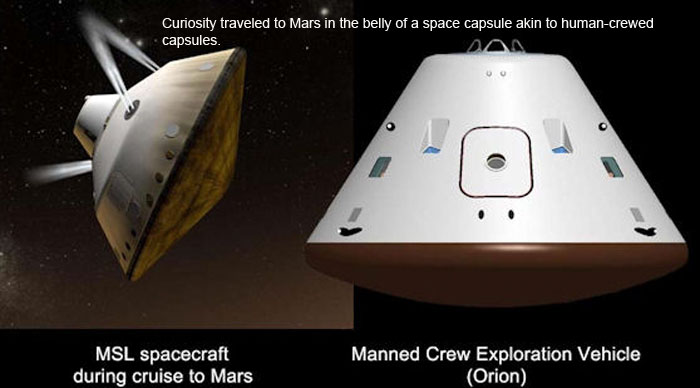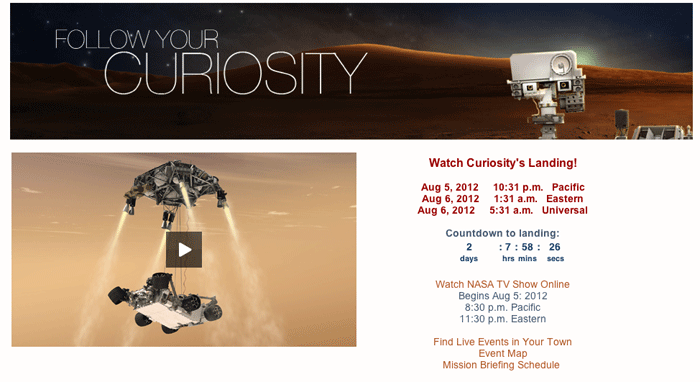-

-
Australia is "all ears" for Mars landing
NASA's Mars Science Laboratory will land on Mars on Monday 6 August (AEST). The Canberra Deep Space Communication Complex, which CSIRO manages on behalf of NASA, will be the main tracking station for the landing. CSIRO's Parkes telescope ("The Dish") will also be receiving signals, as a backup.
-

-
Dishes in Australia will be the ones following NASA’s Mars Science Laboratory mission when it lands on Monday (6 August) after a nail-biting series of manoeuvres.
The Canberra Deep Space Communication Complex (CDSCC), which CSIRO manages on NASA's behalf, will be the main tracking station for landing activities. Its 70-m and two 34-m antennas will receive signals from the spacecraft both directly and then relayed through another NASA spacecraft, Mars Odyssey, which is already in orbit around the red planet.
"The expertise of Australian personnel in space communications and CSIRO's partnership with NASA will be showcased during this critical event in the Mars Science Laboratory's mission"
Dr Phil Diamond, Chief, CSIRO Astronomy and Space Science
CSIRO's 64-m Parkes telescope will record signals directly from the spacecraft as a backup in case there is a problem with the relaying. But as the spacecraft descends, it will drop below the Martian horizon (and out of direct sight of Earth-based antennas) about two minutes before touchdown, and Parkes will cease receiving its signals.
"The expertise of Australian personnel in space communications and CSIRO's partnership with NASA will be showcased during this critical event in the Mars Science Laboratory's mission," says Chief of CSIRO Astronomy and Space Science, Dr Phil Diamond. "All of our technology and our people are ready."
A third, smaller, antenna managed by the European Space Agency (ESA) at New Norcia near Perth in WA will provide extra redundancy. It will receive signals from the spacecraft recorded and re-sent through ESA's Mars Express satellite, which is in orbit around Mars.
Signals from the Canberra station will be sent directly to mission scientists at NASA's Jet Propulsion Laboratory (JPL) in Pasadena, California. Data from Parkes and New Norcia will be sent later for analysis.
The spacecraft will slam into the atmosphere at 20 000 km per hour. Over the next seven minutes the craft and then its payload must be slowed to essentially zero.
The landing has several stages: cruise, deployment of the entry capsule and then the parachute, separation of the heat shield, and finally the operation of the "skycrane" that is to lower the 900-kg rover, Curiosity, onto the Martian surface.
As each stage is successfully completed the spacecraft will send a unique tone indicating that it has occurred.
During the landing, the mission scientists can only watch and wait. They call this time the "seven minutes of terror".
The exact landing time for the spacecraft is determined by several factors, including descent time on the parachute, Martian winds, and any variation how the spacecraft flies under power before the landing. Confirmation of a touchdown signal could be received on Earth at 3.31 pm AEST at the earliest.
Winds could mean that descent time on the parachute is longer, but at this time of year on Mars the weather is very stable and is not expected to cause any problems.
If the final set of tones is not heard, Mars Odyssey will listen for them again when it orbits over the landing site 1.5 hours later.
The landing is completely pre-programmed: it cannot be controlled from Earth because of the time that it takes to send a radio signal to Mars and then receive a response on Earth (about 14 minutes each way). The last opportunity to send the spacecraft any commands will be two hours before it enters the atmosphere. "After that, it's on its own," said Glen Nagle, Public Outreach Manager at the Canberra Deep Space Communication Complex.
Signals from the Canberra station will be sent directly to mission scientists at NASA's Jet Propulsion Laboratory (JPL) in Pasadena, California. Data from Parkes and New Norcia will be sent later for analysis.
The spacecraft will slam into the atmosphere at 20 000 km per hour. Over the next seven minutes the craft and then its payload must be slowed to essentially zero.
The landing has several stages: cruise, deployment of the entry capsule and then the parachute, separation of the heat shield, and finally the operation of the "skycrane" that is to lower the 900-kg rover, Curiosity, onto the Martian surface.
As each stage is successfully completed the spacecraft will send a unique tone indicating that it has occurred.
During the landing, the mission scientists can only watch and wait. They call this time the "seven minutes of terror".
The exact landing time for the spacecraft is determined by several factors, including descent time on the parachute, Martian winds, and any variation how the spacecraft flies under power before the landing. Confirmation of a touchdown signal could be received on Earth at 3.31 pm AEST at the earliest.
Winds could mean that descent time on the parachute is longer, but at this time of year on Mars the weather is very stable and is not expected to cause any problems.
If the final set of tones is not heard, Mars Odyssey will listen for them again when it orbits over the landing site 1.5 hours later.
The landing is completely pre-programmed: it cannot be controlled from Earth because of the time that it takes to send a radio signal to Mars and then receive a response on Earth (about 14 minutes each way). The last opportunity to send the spacecraft any commands will be two hours before it enters the atmosphere. "After that, it's on its own," said Glen Nagle, Public Outreach Manager at the Canberra Deep Space Communication Complex.
-
................................................................................................................................................................................................................................
-
Curiosity's First Daredevil Stunt
August 2, 2012: When Curiosity enters the Martian atmosphere on August 6th, setting in motion "the seven minutes of terror" that people around the world have anticipated since launch a year ago, the intrepid rover will actually be performing the mission's second daredevil stunt.
The first was completed in July.
For the past nine months, Curiosity has been acting as a stunt double for astronauts, exposing itself to the same cosmic radiation humans would experience following the same route to Mars1.
"Curiosity has been hit by five major flares and solar particle events in the Earth-Mars expanse," says Don Hassler of the Southwest Research Institute in Boulder, Colorado. "The rover is safe, and it has been beaming back invaluable data."
-

-
Unlike previous Mars rovers, Curiosity is equipped with an instrument that measures space radiation. The Radiation Assessment Detector, nicknamed "RAD," counts cosmic rays, neutrons, protons and other particles over a wide range of biologically-interesting energies. RADs prime mission is to investigate the radiation environment on the surface of Mars, but NASA turned it on during the cruise phase so that it could sense radiation en route to Mars as well.
Curiosity’s location inside the spacecraft is key to the experiment.
"Curiosity is riding to Mars in the belly of the spacecraft, similar to where an astronaut would be," explains Hassler, RAD's principal investigator. "This means the rover absorbs deep-space radiation storms the same way a real astronaut would."
Even supercomputers have trouble calculating exactly what happens when high-energy cosmic rays and solar energetic particles hit the walls of a spacecraft. One particle hits another; fragments fly; the fragments themselves crash into other molecules.
"It’s very complicated. Curiosity has given us a chance to measure what happens in a real-life situation"
-

-
RAD charged particle flux observations during ~7 months of cruise included contributions from 5 solar energetic particle events. The inset compares the particle flux observed by RAD to that observed by instruments on the ACE spacecraft. The MSL spacecraft structure (backshell, heatshield, etc.) provided significant shielding from deep space radiation, significantly reducing the particle flux compared to ACE.
-
Hassler says the walls of the Mars Science Lab spacecraft have performed as expected: Only the strongest radiation storms have made it inside. Moreover, charged particles penetrating the hull have been slowed down and fragmented by their interaction with the spacecraft's metal skin.
"It's not only the walls that matter, however," he points out. "The spacecraft's hydrazine tanks and other components contribute some protection, too."
Data from Curiosity will help sort out how different subsystems block and respond to cosmic rays and solar radiation. This is information designers of human-crewed spacecraft urgently need to know. "We plan to publish results in a refereed journal later this year," says Hassler.
RAD was turned off July 13th in preparation for landing. Mission controllers will turn it on again after Curiosity sets down in Gale crater. Then researchers will learn what radiation awaits astronauts on the surface of Mars itself.
"No one has ever before measured this kind of radiation from the surface of another planet." Says Hassler, "we’re just getting started."
Quelle:NASA
-



6399 Views
